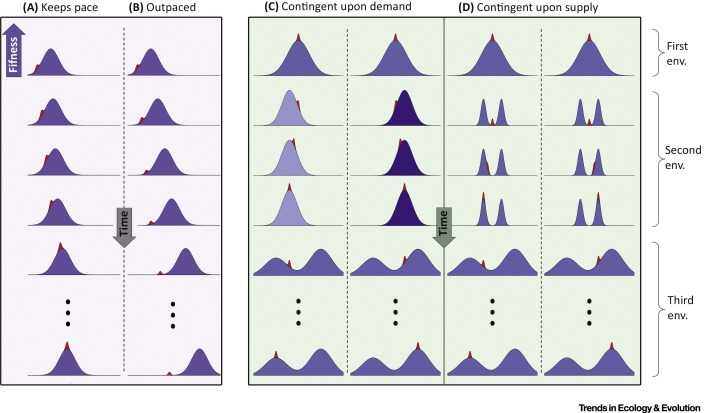标签:ssi port exp bsp inline 4.6 isp dem lte
这是Trends in Ecology & Evolution上的一篇新review,这个期刊影响因子超过10,在生态学里还是非常有分量。我的研究生课题是关于进化的,属于分子生态,群体遗传学,蹭着热点做表观遗传。这么简洁的题目,立刻吸引了我,不过我没看懂supply和demand究竟是什么意思?因为摘要里谈到了争议的表观遗传在进化中的地位。我还是决定快速扫一遍这篇总数。
整体上,这边总是很适合做教材,学习进化生态学。
Adaptation to a changing environment is far from simple.Ecological demands on populations can vary temporally and spatially.Likewise, the supply of genetic and epigenetic variation is inherently complex.Supply and demands can interact and alter evolutionary trajectories.To track and predict adaptation,we need better integration across disciplines.


遗传结构(Genetic Architecture)可以揭示群体的简化潜力。
Constraints on Evolvability. Fitness gradient from low (blue) to high (yellow) is plotted as a function of two phenotypic traits. Red points correspond to the phenotypic values of individuals currently present in the population and white points refer to the phenotypic values that could result from mutation and recombination. (A) Available and potential supply allows for adaptation. (B) Available supply (red points) is restricted, and adaptation relies on generating new individuals with different trait values (white points), which in turn is dependent on population size and structure, mutation, and recombination rate. (C) Available and potential supply is restricted, for example, due to genetic architecture or antagonistic selection acting on traits, and thus adaptation is constrained. (D) Variation in current and potential phenotypes exist, but not in the direction required for adaptation.
Glossary
- Additive genetic variation: component of trait variation that is the result of the additive effects of genes.
- Bottlenecks: severe reduction in population size.
- Cryptic genetic variation: standing genetic variation that has little or no effect on phenotypic variation under normal conditions, but generates heritable phenotypic variation under changed environmental or genetic conditions.
- Epiallele: a pair (or group) of identical genes that differ in their methylation.
- Epimutation: a heritable change in gene activity not associated with a change in the DNA sequence but with modification of, for example,methylation status or modification of chromatin.
- Evolvability: the ability of a population to undergo adaptive evolution.
- Genetic drift: changes in allele frequencies due to random sampling from one generation to the next.
- Genetic hitchhiking:allele frequency change of probable neutral locus that is genetically linked to a locus under selection.
- Genetic variation: differences in DNA sequence between individuals.
- Hill–Robertson effect:the probability of fixation of a beneficial mutation can be limited because it finds itself in linkage disequilibrium with a deleterious mutation.
- Linkage disequilibrium:nonrandom association of alleles at two or more loci.
- Linked selection:change of the allele frequency of loci genetically linked to a locus under selection. Includes allele frequency change due to any action of selection positive selection or negative/purifying selection (also referred to as background selection).
- Locus/Loci:a position in the genome, could be a single nucleotide position or 1000s of base pairs of DNA sequence, it can correspond to a gene or many 100s of genes.
- Mutation: a permanent change in the DNA sequence of an individual.
- Mutational load: reduction in fitness due to deleterious mutations carried by a population
- Robustness: the ability of a phenotype to resist perturbation by mutations (or the environment).
Additive genetic variationcomponent of trait variation that is the result of the additive effects of genes.Bottleneckssevere reduction in population size.Cryptic genetic variationstanding genetic variation that has little or no effect on phenotypic variation under normal conditions, but generates heritable phenotypic variation under changed environmental or genetic conditions.Epiallelea pair (or group) of identical genes that differ in their methylation.Epimutationa heritable change in gene activity not associated with a change in the DNA sequence but with modification of, for example, methylation status or modification of chromatin.Evolvabilitythe ability of a population to undergo adaptive evolution.Genetic driftchanges in allele frequencies due to random sampling from one generation to the next.Genetic hitchhikingallele frequency change of probable neutral locus that is genetically linked to a locus under selection.Genetic variationdifferences in DNA sequence between individuals.Hill–Robertson effectthe probability of fixation of a beneficial mutation can be limited because it finds itself in linkage disequilibrium with a deleterious mutation.Linkage disequilibriumnonrandom association of alleles at two or more loci.Linked selectionchange of the allele frequency of loci genetically linked to a locus under selection. Includes allele frequency change due to any action of selection − positive selection or negative/purifying selection (also referred to as background selection).Locus/Locia position in the genome, could be a single nucleotide position or 1000 s of base pairs of DNA sequence, it can correspond to a gene or many 100s of genes.Mutationa permanent change in the DNA sequence of an individual.Mutational loadreduction in fitness due to deleterious mutations carried by a population.Robustnessthe ability of a phenotype to resist perturbation by mutations (or the environment).
Can Evolution Supply What Ecology Demands?
标签:ssi port exp bsp inline 4.6 isp dem lte
原文地址:http://www.cnblogs.com/liulele622/p/6321782.html